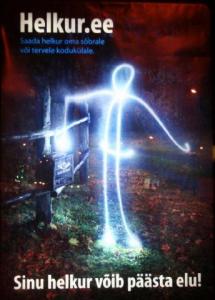
"Send a HELKUR (reflector) to your friend or entire hometown. Your reflector can save your life!" The word for reflector comes from the verb helkima = to sparkle / shimmer and it's serious business in the far north, including Estonia. This campaign encouraged people to give reflectors to their friends and donate larger amounts to rural populations. Photo: Riina Kindlam
Darkness and people dressed in dark are an issue here between 58 and 59 degrees north latitude. That corresponds to where the Canadian prairie provinces meet the Northwest Territories. Whitehorse, Yukon and Helsinki are 60 degrees north, whilst Toronto is on line with Florence, Italy on the 43rd parallel. In case you were wondering.
Advertisement / Reklaam
Advertisement / Reklaam
Helkur-awareness was quick to arrive from Estonia's neighbours to the N and NW, but there are still numerous senseless accidents and deaths each winter involving hard to see pedestrians (jalakäijad) and vehicles. And so the public awareness campaigns continue, brought to you by the liiklusohutus (traffic safety) people at the Maanteeamet or Estonian Road Administration. Tee = road, maantee = highway and kiirtee (literally "fast road") = freeway or express highway, which Estonians only encounter abroad.Children's winter jackets and snowsuits come adorned with strips of reflective material, but in order to counter the idea that helkurid are only for children, new varieties have been introduced, including those in the form of arm and leg hugging bands. Helkurid provide a good surface on which to advertise and have even become subtle fashion statements, acquiring many interesting designs, colours, shapes and characters (glorified pendants). But beware of libahelkurid – (the prefix liba = fake), wanna-bes made of material which does not reflect well enough! Helkurid must be seen by a driver from a distance of at least 130-150 metres in order to have sufficient time to brake and ideally seen from as many angles as possible.
Official helkur protocol states the least (and optimal) life-saving sparkle a pedestrian in Estonia should don is a light-coloured reflector (ideally certified), made from hard plastic and measuring ca 5 cm across hanging on the right side of one's outerwear at approx. 40-60 cm from the ground (the height of car headlights) on a 10-20 cm string, so it spins and twirls. A second reflector on the left side is a additional investment.
For someone in a well-lit big city with fair weather this might sound excessive and silly, but on a winter's night in rural Estonia, experience has it that it's worth making those you care about sparkle – "Pane need, kellest hoolid, pimedal ajal särama!" in order to be there for the ones you love – "Ole oma lähedaste jaoks olemas." Not something to take lightly.
Advertisement / Reklaam
Advertisement / Reklaam

